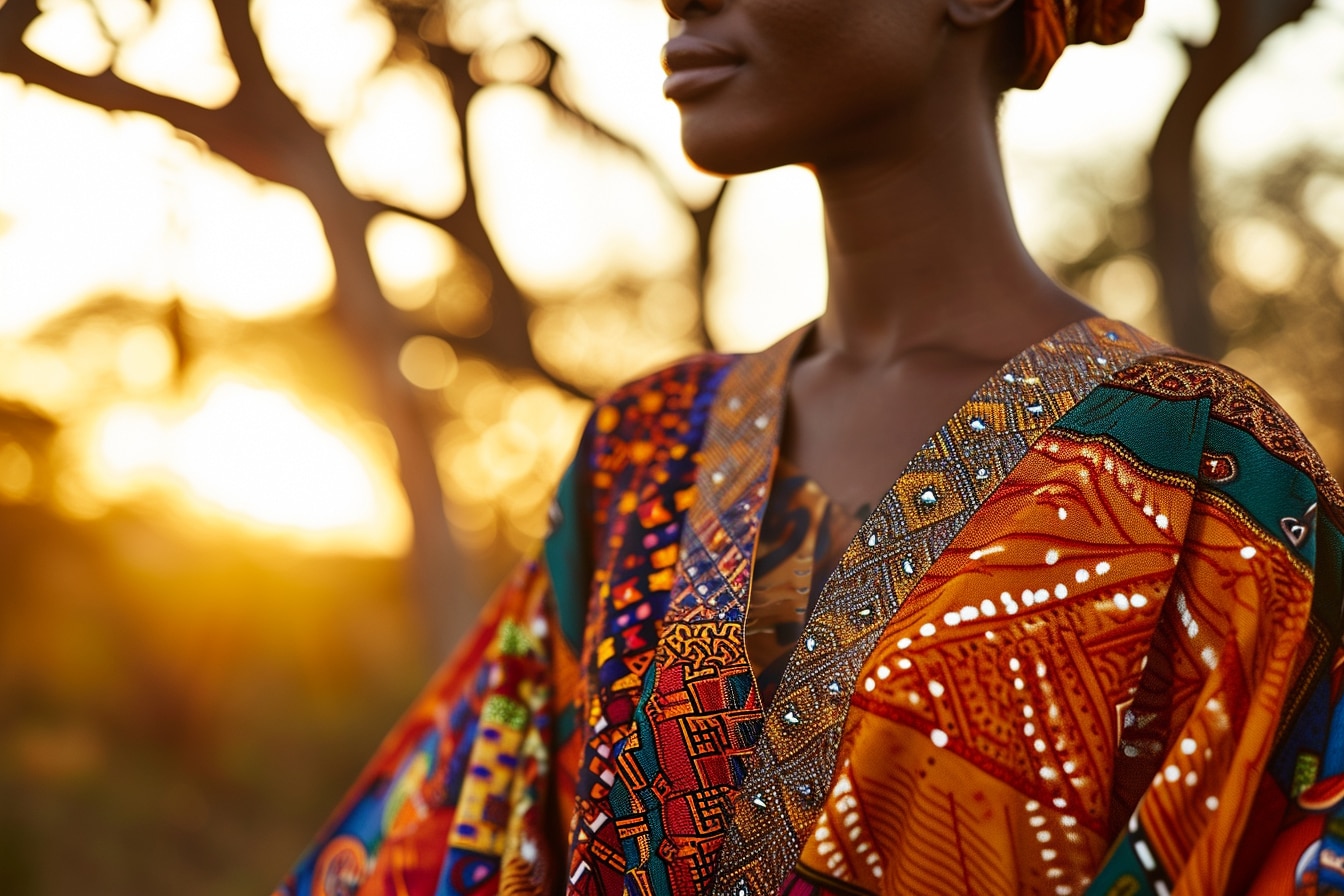Theevolution of African fashion over the years reveals a rich and complex panorama, reflecting both ancestral traditions and contemporary trends. It begins with a solid historical framework, marked by styles and fabrics characteristic of the different cultures and regions of Africa, which we will explore in the first part of our presentation. Next, our analysis will look at how social and political movements have influenced this fashion, bringing new meanings and broadening its spectrum of expression. Finally, we’ll look at the dynamic nature of modern African fashion, which is now boldly and creatively integrating itself into the global textile market. Our journey through African fabrics and patterns will reveal a history of transformation and cultural affirmation.
The origins and traditions of African fashion
The history of African fashion is rooted in a rich soil of cultural expression, where each ethnic group offers its own story woven right into the fabric. From the time of the Egyptian pharaohs, when finely worked linen defined social status, to the West African traditions of Ghanaian kente weaving, a whole kaleidoscope of clothing has been woven through the ages. Ancestral techniques, such as Touareg indigo dyeing or meticulous Peul embroidery, have been handed down from generation to generation, nourishing the visual identity of these peoples.
These emblematic elements are not just garments, but also embody powerful symbols of belonging and social continuity. The Malian bogolan, for example, with its geometric patterns charged with age-old cosmological and social meanings, tells the story of an entire community. Similarly, Maasai beads are more than mere ornaments; they reveal age, marital status and social rank within the tribe.
On the African continent, every piece of clothing is imbued with this timeless heritage, which deserves recognition and respect. It is essential to contemplate these traditions not only as an artistic treasure to be preserved, but also as the inalienable foundations of what African fashion truly represents in its deepest essence: a sparkling mirror of cultural and historical values.
The influence of social and political movements on African fashion
African fashion, a mirror of society, has not failed to reflect the turbulence and socio-political evolutions of the continent. In a context where every weave can be interpreted as a metaphor for a historical memory, it is undeniable that social movements and political revolutions have shaped African aesthetics. Take, for example, the post-colonial era, which saw the birth of a cultural renaissance reflected in the return to traditional textiles such as wax and bogolan, flaunted as standards of a rediscovered identity.
Even more recently, with the emergence of feminist movements on the continent, fashion has taken on bold expressions of female autonomy and power. Designers began infusing their creations with symbols of strength and equity, giving life to pieces that do more than clothe; they tell stories of emancipation. The wearing of certain outfits is no longer limited to a question of style, but becomes a vector of political affirmation.
But perhaps it’s during major democratic transitions that this correlation between fashion and politics reaches its apogee. From election campaigns to pacifist civil rights marches, committed actors have often opted for a ‘protest wardrobe’, donning garments branded with slogans or colors representative of their cause. These items of clothing are then transformed into vehicles for social protest.
Nor does economic volatility leave the world of fashion design on the sidelines; it demands constant adaptability and innovation. So, in a pragmatic approach to fluctuating local economic conditions, some avant-garde designers consciously choose recycled or recyclable materials to make their case for sustainable development.
Theinescapable interweaving of the social sphere and the stylistic universe is evident in the African millinery landscape. No pivotal era has failed to leave its mark on these historically-charged fabrics – a living breath that bears constant witness to the transformations undergone by an ever-changing continent.
Modern African fashion and its integration into the global market
The current craze for African fashion on the international market is a phenomenon that testifies to the spectacular evolution of the sector. At a time when every corner of the globe aspires to greater diversity, African fashion embodies this cultural richness with its shimmering textures and inherited symbolic motifs. Contemporary designers, armed with ancestral know-how and innovative vision, fashion pieces that honor traditions while embracing a universal aesthetic.
The distinctive character of modern African fashion lies in its ability to fuse custom and modernity. This hybridization is reflected in the creation of outfits that combine Western cuts with emblematic fabrics such as wax, bogolan or hand-woven silk, valorizing the textile heritage specific to each African region. The colorful palette, once reserved for ceremonies and rituals, is now making its mark on international catwalks, bringing a breath of freshness and optimism.
Digital platforms have played a key role in this move towards global recognition. The Internet has enabled African designers to showcase their work far beyond the continent’s borders, exposing them to fashionistas the world over. Likewise, major events such as Lagos Fashion Week have given these talents the opportunity to showcase their collections and engage in dialogue with an international public eager for novelty.
The growing integration of African creations into global distribution channels also confirms their growing power in the fashion market. Collaborations with major labels and fashion houses illustrate this unlimited potential, while global icons proudly wear these creations, attesting to the rightful place that modern African fashion wishes to definitively take on the global chessboard of style.
We recommend these other pages:

